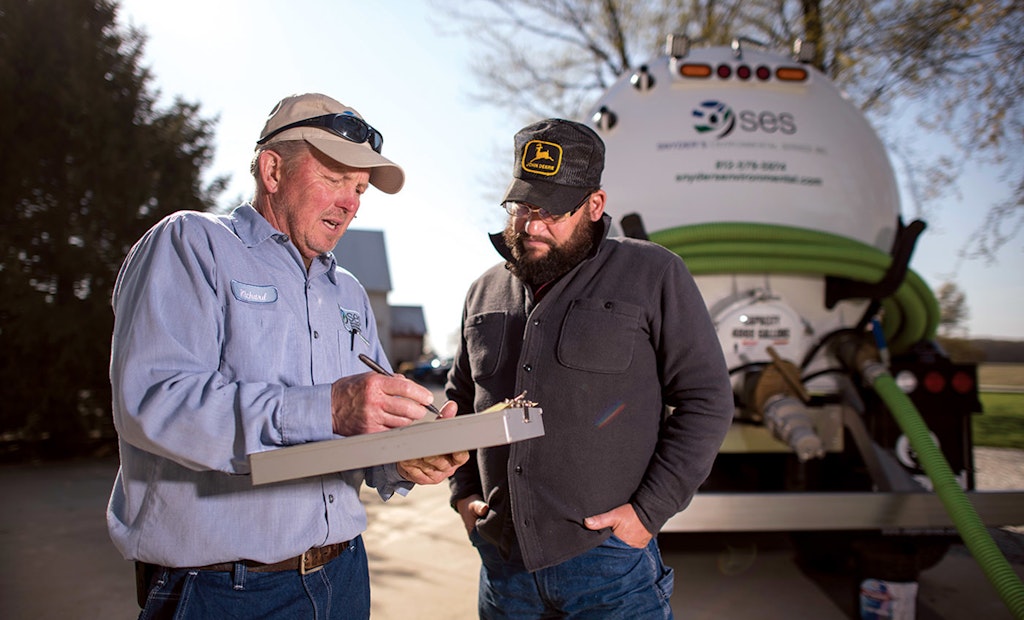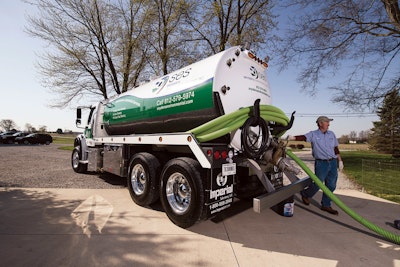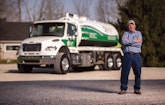
Richard Snyder, left, prepares an invoice for a customer. Taking time to educate the customer is a key to quality service, Snyder says.
Richard Snyder believes in having good, up-to-date equipment for his septic service business and even showed off his latest vacuum truck at the 2018 Water & Wastewater Equipment, Treatment & Transport Show. But when he got started in 1987, it didn’t take him long to also figure out that working smarter, not harder, was the path to increased profitability.
And that often comes from intangible assets like education, information and image. These can save money, increase productivity and give a business owner confidence. They permeate all aspects of Snyder’s operation, whether in the form of a special invoice he designed, taking his team to the WWETT Show every year, or making sure property owners understand the workings of their septic system. And now with 30 years’ experience under his belt, Snyder is happy to pass along any advice that might help other pumpers.
Snyder’s Environmental Service is located on a 6-acre property in Columbus, Indiana. Snyder calls his crew “a good group of guys” — brother Larry Snyder, nephew Tyler Maggard, Marty Wells and Robert Phares. Richard Snyder takes care of the bookwork; Larry Snyder manages the money, taxes and payroll; and before his passing, Richard Snyder’s uncle, Jack Snyder, handled the phones. That’s a job Richard Snyder feels is critical and should be done by someone knowledgeable about the company and the industry. So he and the crew now take calls in the field.
They work in a 30-mile radius with three lines of business — septic work (pumping, inspections and minor repairs), drain cleaning, and grease trap service — about one-third each. And they have both residential and commercial accounts.
In the 1970s and 1980s, Snyder worked at his uncle’s farm drainage company. He took the business over in 1987 but ran into bad luck the following year when a severe drought eliminated the need for his services. “So, I started putting in septic systems because I had a backhoe and a little dozer,” he says. By the next year, frustrated with waiting for pumpers to empty a tank before he could do his work, he bought a 1974 Chevrolet vacuum truck with a 1,500-gallon tank and started offering pumping services.
For 10 years, he ran both companies with the help of his wife, Linda, and teenage sons Erich and David. Then in 2000, he sold the drainage company when he realized he could make more money just doing septic work. He knew there would always be more people with septic problems than farmers with drainage problems.
EQUIPMENT LINEUP
In 2017 the company pumped a record 750 tanks, a number that surprised even Snyder. That growth led him to buy a third vacuum truck — a 2018 Freightliner M2 106 from Imperial Industries outfitted with a 4,000-gallon aluminum tank and a National Vacuum Equipment 4310 blower. It was done just in time for Imperial Industries to display it at the WWETT Show in Indianapolis before handing it over to Snyder. They also have a 2010 Freightliner M2 106 with a 3,600-gallon steel tank and a 2000 International 4900 with a 2,300-gallon steel tank, both with National Vacuum Equipment pumps and built out by Imperial Industries.
Equipment includes an Innovative Equipment TMX towable mini-excavator, as well as a few pieces of machinery left over from their previous business — a 1992 Ford L8000 with a Galion dump body (“in case we need a load of stone”), a John Deere 350 dozer and a 1995 Case 580L backhoe.
Grease trap work is done using the smaller septic truck, as well as a Conde ProVac portable pump system (Westmoor). Grease is transferred from the ProVac to an Imperial Industries 450-gallon aluminum tank before transfer again to the septic truck. The small tanks are hauled in a 12-foot Wells Cargo insulated, heated trailer pulled by a 2003 Ford F‑250. While septage is disposed of at the local treatment plant, grease has to be taken 50 miles to Indianapolis.
Drain cleaning equipment, hauled in a 16-foot enclosed Wells Cargo trailer, includes Spartan Tool cables (model 1065 for large projects, 300 for medium, and two 100s for small sink drains), an EasyCAM pipe camera, a RIDGID SeeSnake camera, General Pipe Cleaners jetters (J‑2900 gas and J‑1450 electric), and a Prototek locator. They also have a Spartan Warrior 300-gallon trailer jetter and carry a generator in case a job site has no electricity.
BETTER INVOICES
Five years after Snyder started his company, he had an insight that he says dramatically improved his efficiency and made his job a lot easier. “I realized the small invoices I was giving my customers didn’t tell me anything for future use,” he says. The invoice included only the customer name, address, phone number and price for the service.
So he completely redesigned the invoice. It’s now 8.5 inches by 11 inches, with detailed information about the tank, the property, how many technicians and how many feet of hose are needed to service the site, and whether they need to bring their mini-excavator. It also has a drawing of the property marking the tank location.
“That has been the smartest thing I ever did,” Snyder says, “because it makes the job faster and easier the next time. I tell my guys a septic tank is going to be in the same place for maybe 100 years but there’ll be at least five or six owners we’re going to deal with on it and we’re always going to know where the tank is and how deep.”
The invoices are entered into a computer spreadsheet. Drivers take copies with them when they return to a property. And the service trucks carry laptops so technicians can pull up an invoice for last-minute calls.
The company sends reminder cards to customers. “We want that repeat business,” Snyder says, “because we already know all about their tank. Information is valuable.” Realtors also call to get details for properties, and those contacts lead to inspection referrals.
BE THE TEACHER
Snyder never made it to college but is a strong proponent of education for himself and others. He says he looks forward to reading Pumper every month because he always learns something. And he wouldn’t miss the WWETT Show. In fact, he brings his whole team on alternate days. Fortunately the show is only 50 miles away in Indianapolis. In 2018 he also brought a couple of maintenance workers from the local school district and a fellow from a mechanical contracting company. “They had never been and were very surprised,” he says. He also enjoyed offering advice and a copy of his invoice to some young pumpers just getting started. “When I first started doing this, I was the young guy, and now I’m the old guy,” he says.
Snyder also enjoys educating customers. “I think if you do that, you win a customer for life. You have to be confident in what you’re telling them, show them, point to things.” He’ll even talk to people who aren’t his customers. He recently got a call from a homeowner 50 miles away and diagnosed his problem over the phone as a plugged outlet filter. He explained the new Indiana law requiring a filter and how to remove and clean it.
“He called me back the next day and was so appreciative,” Snyder says. “I felt satisfaction out of helping somebody I didn’t even know and got nothing out of it.”
Despite his enthusiasm for education, there was one thing that intimidated Snyder, namely technology. But in 2000, his accountant told him he had to get a computer. “I knew nothing about them,” he says. “But if she hadn’t done that, I don’t know where we’d be today.” Now he uses it every day. “I get up at 2 or 3 a.m. and prepare the previous day’s invoices, punch them into a spreadsheet and scan them,” he says. “Then Larry comes in and puts them into the accounting software.”
He also put off getting a smartphone, but now says couldn’t live without it. It’s been especially helpful for taking photos of job sites to visually supplement the detailed information on his invoice.
PUBLIC PERCEPTION
Snyder says 30 years ago the septic industry had a negative image, which he fought hard against right from the start because of his children.
“My sons were 7 and 8 and I had a fear as a parent — because I put my name on the side of this big old white tank — of kids making fun of them because their dad cleaned septic tanks. I wanted to show people we know what we’re doing and we’re clean about it. Sometimes you get dirty but that’s what uniforms are for. You can get dirty but you don’t have to wear it. And we try to keep clean trucks.”
Professionalism also means charging a sensible price regardless of what others charge so Snyder can pay for equipment upgrades and benefits for his staff and run a profitable company. He is also particular about the language he uses. He doesn’t say he pumps septic tanks, he says he cleans them, which implies a more thorough job.
Snyder was ready to create a fresh new look for the company in 2017. With the help of a local firm, BigFish Design, they improved the website and designed a new logo including the acronym SES. He immediately put the logo on his new septic truck. “It looks great going down the road,” he says. “When I see a truck, I always look to see what it says on the side and I think a lot of people do that.”
NOT SLOWING DOWN
Snyder says the company has grown slowly but steadily over the years and there’s no end in sight. He has no regrets choosing the course he did and gets satisfaction out of helping people and getting a job done. Every site is a little different, which keeps it interesting.
At 62, he says he’d be happy if his nephew took over the business some day but he currently has no plans to retire. “When you work for yourself so long, you’ve got it ingrained in you that you’ve got to stay busy. My legs might tell me I’m 62 sometimes but I don’t feel too bad. I think I could still outwork most of them. You use your brain a little more, hopefully, instead of your back.”
Taking care of the staff
Tetanus and hepatitis shots are just one of the benefits Richard Snyder of Snyder’s Environmental Service provides for his employees to ensure their safety. “We’ve never had an issue but I don’t want anybody getting sick because of something we do,” he says. He also makes sure the team has proper clothing for the work they do and different weather conditions. He supplies shirts, pants, coveralls, hooded sweatshirts, coats, gloves and baseball hats. Next year he thinks he may add sock hats for cold weather. He says they buy cases of latex gloves.
These items not only protect the employees but present a professional image to the public. “It’s always the first impression,” he says. “And I believe in looking professional.”
He also takes care of the staff financially by providing good wages, health insurance, and paid time off for holidays, vacations, and sick days.










